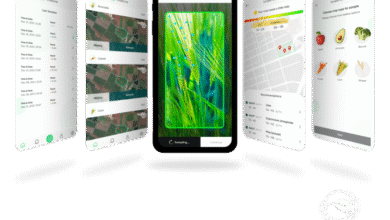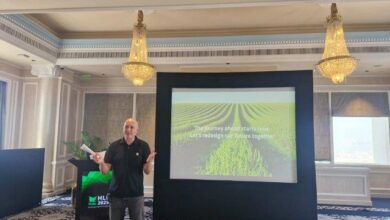Herbaceous Perennials from Israel: A New Concept for Traditional Crops
A novel and original method allowing to produce and transport non-dormant plants, which will sprout immediately after re-planting.
Dr. Rina Kamenetsky

ornamental herbaceous perennials are grown for their ornamental value throughout the world and are utilized mainly for landscaping, private gardening and commercial production of potted plants. for all these purposes, commercial production of good-quality propagation material is a necessary condition.
ornamental herbaceous plants present a diverse group of species which vary greatly in growth patterns, tolerance to heat and cold, environmental demands and postharvest storage. there are nurseries that carry hundreds of species and varieties as a result of the constant growth in public demand for new products and varieties. in commercial practice, herbaceous perennials are usually produced from seed propagated plugs, vegetative liners or bare-rooted propagating units. there are significant advantages to bare-root production – availability in a range of sizes and grades, production of a bigger plant in a shorter time, and the light weight of bare-root plants. in addition, the root system can be inspected, and inferior or defective roots can be removed.
.jpg)
fig. 1 experimental production field in southern israel. february 13, 2006
in the temperate zones of europe and north america, bare-root plant production involves growing plants in rows or beds for one to three years. these plants are then harvested in the fall, cleaned, and stored at low temperatures until marketing in spring (scheme 1a). throughout the winter and spring, bare-root plants are removed from storage and shipped to wholesale and retail nurseries. in temperate zones the above-ground organs of most herbaceous perennials die off in the fall and only the over-wintering crown or root structure persists underground. the seasonal constraints in this production system dictate the schedule of plant harvest, transportation and re-planting during the “dormant” season in november-march. in addition, active growth and flowering of many species require vernalization, when the plants should be subjected to relatively low temperatures for several weeks.
.jpg)
right: fig. 2 gaura plant after five months of growth in the field, at harvest, march 2005
left: fig. 3 gaura ‘passionate’: plant sprouting after storage under different conditions, april 2005
scheme 1 production design in the temperate zones of europe (a) and israel (b)
being a significant center of ornamental horticulture, israel invests considerable efforts in the development of ornamental crops suitable for cultivation under local conditions, as well as in the development of new technologies for crop cultivation, storage and transportation. recently, the possibility of bare-root production of herbaceous perennials was proven through scientific experiments in collaboration with leading commercial producers. the new concept of bare-root production in israel illustrates the possibilities for cultivating ornamental plants with special physiological traits.
the potential for bare-root production in israel is based on the unique climatic conditions of this country: high light intensity, warm winter temperatures and the short photoperiod during plant growth during winter. the plants can be grown during october-march, harvested in early spring, and immediately transported to international markets (scheme 1b). plant assortment for these specific environmental conditions can be very large – from species without chilling requirements, originating in subtropical and arid regions, to thermo-periodic species originating in the moderate zones.
.jpg)
fig. 4. plant development at the customer’s nursery, usa, june 2, 2006
(courtesy of carmel agrexco, 2006)
a- fast growth of root system in gaura ‘passionate’:
b- development of flower buds in gaura ‘passionate’: 6 weeks after re-planting
our preliminary trials have proven the possibility of the effective growth, transportation and re-planting of several popular varieties of gaura, sedum, euphorbia, gailardia and other ornamentals perennials. plants are grown from vegetative liners during the short winter period, when environmental conditions (warm temperatures and short photoperiod) are favorable for the vegetative plant development, but pest and disease infections are limited. the original propagating units (rooted cuttings) meet international standards as disease-, virus- and pest-free plant material. thus, during the growth period the developing plants maintain a high level of health and vigor.
plants are grown under unusual environmental conditions: warm temperatures in combination with short (ca.8-9hours) photoperiods. this practice allows many species to maintain active growth, not to go into dormancy and to continue accumulation of the vegetative mass. after harvest, the plants are sorted, cleaned, pruned, stored and transported under relatively low temperature, which affects “growth arrest”, but not dormancy induction. this novel and original method allows us to produce and transport non-dormant plants, which will sprout immediately after re-planting.
.jpg)
.jpg)
.png)
right to left: fig.5 euphorbia amygdaloides ‘humpty dumpty‘ ; fig.6 gailardia ; fig.7 gaura lindheimeri ‘passionate blush’
.jpg)
.png)
fig. 8 sedum telephium ‘autumn joy’ ; fig. 9 pelargonium violareum
vernalization is a requirement of many temperate species for a period of low temperatures. the end of a relatively long period of cold temperature serves plants as a cue to indicate that winter is over, ensuring that flowering occurs under favorable conditions of spring. vernalization results in the ability for reproductive development at the shoot apical meristem – the active growing point of the plant. since during storage and transportation the plants produced in israel do not enter dormancy, their meristems are active, and the accumulation of vernalization signals for the transition to floral development is effective.
our initial trials have proven the positive potential for bare-root production of herbaceous perennials under specific environmental conditions in israel. our production is characterized by four most important advantages:
1. the original propagating units are disease-, virus- and pest-free
2. the short period of plant growth during the winter season allows for the production of vigorous and healthy plant material
3. non-dormant plants, which are stored and transported at the physiological state of “growth arrest”, sprout and develop immediately after re-planting
4. active meristems accumulate vernalization signals for flowering during transportation at low temperatures, which allow for fast plant development and flowering at the customers’ nursery.
*photographs courtesy of “hishtil”, 2006
author: dr. rina kamenetsky, aro, the volcani center, israel
published in israel agriculture, 2007




